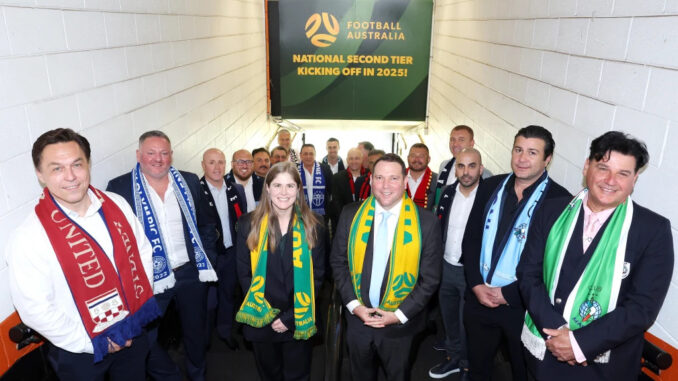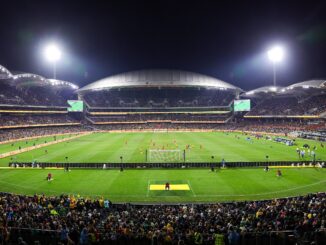
Football Australia CEO, James Johnson, has moved to allay fears the proposed National Second Division may not get off the ground, boldly declaring the competition “will exist” ahead of its planned launch in 2025.
The proposed competition, which would sit below the A-League Men’s competition, but with no promotion or relegation linking the two, has been talked about for a long time, and late last year FA announced the eight foundation clubs accepted into the competition, flagging a further process to find an additional two to four teams to complete the competition.
Johnson had previously hailed the planned competition as “transformative” for the game in Australia, acting as an important step in reconnecting the pyramid of the game and offering countless more professional opportunities for players, coaches and administrators.
The governing body has even gone so far as to register a name for the competition – the ‘Australian Championship’ – and has gone to market for a new television deal with the second division as part of its offering, with Johnson also confirming an announcement regarding that deal is imminent.
But a report in the Sydney Morning Herald on Tuesday by respected journalist Vince Rugari suggested the process has failed to find the required number of extra teams to make the competition viable, leaving the competition – at least in it’s current form of a standalone home-and-away competition – in a precarious state.
Ahead of a board meeting to discuss the matter on Thursday, Johnson, who was in Adelaide on Wednesday announcing the return of the Socceroos to the South Australian capital for the first time since 2017, remained bullish that the competition will still go ahead in 2025.
“We will have a (national) second tier… it will exist,” Johnson exclusively told The Asian Game on Wednesday.
The executive, who is expected to extend his contract, which expires at the end of this year, to remain in charge of governing football in Australia, did concede, however, that the format of the competition remains up for debate.
That marks a significant shift in messaging from FA, who only last year, when announcing the eight foundation clubs, noted the only two formats under consideration at that time were either a 10-team league or a 12-team league, both of which would operate on a home-and-away basis with a finals series.
“We’re going to debate it at our board meeting,” Johnson said. “And then, once we’ve settled internally on what our preference is, we need to talk to the clubs. There’s eight clubs that have done a phenomenal job to date, going through a process, and we need to talk to them about what the future looks like.”
The clubs, on the whole, prefer a traditional league structure, separating them from state-based National Premier League (NPL) competitions and playing in a home-and-away format against the other 10 to 12 teams of the second division.
The other model now back under consideration is a ‘Champions League’ model, whereby the clubs remain in their state-based NPL competitions and play a separate competition at the end of their season. It is a model, however, that has always faced significant opposition from the clubs looking to be involved.
“What the competition formats will look like, that’s what we’ve got to debate,” Johnson conceded.
“We need to get the right amount of clubs on board if we want to have a sustainable second tier. We’ve gone through a process, a lengthy process. We’re still in that process, and we’ll have to talk to what the format will be, but we’ll have a second tier, that’s clear.
“We can have a second tier, there’s no issues with that. I think there’s a difference, though, between a standalone home-and-away competition, where clubs move out of the current NPLs, and a second tier where perhaps clubs are guaranteed to play in a model, like a Champions League model, at the back end of the NPL season.
“They’re both second tiers, and these models exist around the world. Brazil is a great example, where the second tier of football is played at state level, and then it filters into a national level at the back end; that’s a second tier, and that could be a second tier here.”
Embed from Getty ImagesThe eight foundation clubs confirmed for the competition to date are APIA Leichhardt (NSW), Avondale FC (VIC), Marconi Stallions (NSW), Preston Lions (VIC), South Melbourne (VIC), Sydney Olympic (VIC), Sydney United 58 (NSW) and Wollongong Wolves (NSW).
The fact that the eight teams are exclusively from just two states, and almost exclusively from Sydney and Melbourne, with Wollongong the only regional outfit, also remains a bone of contention for what is notionally meant to be a national competition.
While attempting to alleviate concern over one league, Johnson also declared he was not worried about the future of the top-tier A-League competition, despite its clubs coming under increasing financial strain, with their annual distribution from the Australian Professional Leagues being slashed to just over $500,000 per season.
“I’m not worried about the A-League,” he said.
“Our role is to regulate the league, it’s not to operate it. That’s for the APL. We’re also, as the governing body of the sport, we’ve got a broader role to play to support the A-League, and we’re looking at ways right now that we can help the A-League increase its revenues and reduce some of its costs so that the distribution can improve in future years.
“But it’s not all doom and gloom for the A-League. I mean, if we look at the types of players that are being produced by clubs right now, we’re seeing more transfer revenue come into the A-League and into the clubs than we’ve ever seen before.
“We’re seeing players move directly from a club like Adelaide, for example, right to Bayern Munich. So look, there’s a lot of work to do. The product is very, very good on the pitch, and the metrics are starting to increase for the A-League, both in terms of the broadcast numbers and also the match day attendance.
“There is definitely some work to do, and our role is to to help the league and the clubs head further north.”




